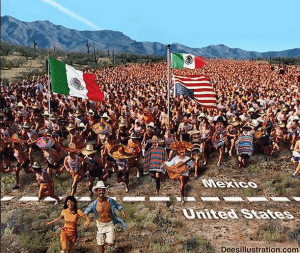PowerLine and CLAREMONT REVIEW Detect, With Alarm, The "Browning Of America"
By Paul Nachman
03/18/2015
In CRB: THE BROWNING OF AMERICA, Scott Johnson, a Minneapolis lawyer and one of the principals at the prominent PowerLine blog, called attention Tuesday to a striking piece in the latest Claremont Review of Books quarterly.
Wrote Johnson:
In Reflections on the Revolution in Europe: Immigration, Islam and the West, Weekly Standard senior editor Christopher Caldwell looked into Europe’s dire future. It is an eloquent and prescient book that makes no concessions to the imperatives of political correctness.In his CRB review “The Browning of America,” Caldwell turns his gaze to the United States. He sees our refusal to face the unpleasant possibilities presented by our fast-changing demographics. “In days when people spoke more freely about such matters,” Caldwell writes, “dramatic change in the dominant population of the world’s dominant power would have been occasion for speculation and worry” — a far cry from today’s enforced public cheerfulness.
Caldwell outlines his thoughts on our demographic shifts in his review of Brookings Institution demographer William Frey’s recent book, Diversity Explosion: How New Racial Demographics Are Remaking America. While Caldwell faults Frey for his generally rose-colored view of the subject, he credits him for his acuity in identifying likely future conflicts.
Where might these conflicts arise? We already see signs of an increasing racial divide in politics, as whites increasingly tend to vote Republican, while nonwhites continue to record even higher levels of Democratic support. “Our politics,” says Caldwell, “as rejiggered by civil rights laws and affirmative action, assumes a mainstream culture, and the ebbing of the white majority in the United States is going to present genuine governing problems …
So, to be clear, we have Scott Johnson writing a blog about Christopher Caldwell’s review of William Frey’s book on America’s shape-changing demography. There are two welcome developments here.
First, Johnson is the third “PowerLiner” to wade seriously into immigration-related subjects in recent months. (The other two are John Hinderaker and Paul Mirengoff; the fourth PowerLiner, Steven Hayward, seems missing in action on this.)
Second, Caldwell, in his 2010 “Reflections” book, was terrific on Europe’s escalating immigration catastrophe (far worse now!) but seemingly oblivious about immigration’s existential threat to American society. That obliviousness is largely gone.
Both the brief blog by Johnson and Caldwell’s ~3,200-word review are highly worth reading in full. (Most articles in any current issue of the Claremont Review are available only to subscribers, but Caldwell’s new article is freely available now.)
Here’s a brief example illustrating Caldwell’s forthrightness in identifying the essentials of a phenomenon:
Now there are certainly good reasons to be glad of the size of our recent immigration. The U.S. labor force will grow 5% between this decade and 2030, and it would have shrunk considerably otherwise. Yet Frey could do with a reminder that what he is celebrating in passages like these is youth, not diversity, that natives ought to be as capable of bearing the next generation of children as the foreign-born, that their failure to do so may be an effect of something dire rather than the cause of something to be “celebrated,” and that policymakers have seldom been able to predict the outcomes of wholesale demographic change.
I suspect that Caldwell’s “something dire” strongly overlaps with immigration-driven hobbling of “affordable family formation,” one of Steve Sailer’s themes here at VDARE.com.
Conflict arising in ethnic or racial diversity isn’t just a modern phenomenon plaguing Western countries. Judging from Ethnic Conflicts Abroad: Clues to America’s Future? [PDF] by Glaister and Evelyn Elmer, such conflict marks all of human history.
That’s a 1988 monograph published by the American Immigration Control Foundation. Unfortunately, it’s no longer available in print, just online. And its form is a typewritten, single-spaced manuscript of about 100 pages, plus a few pages of charts. So it’s not the most convenient form for reading, but it’s a goldmine of information.
The authors' mini-bios aren’t in the online version, so I've transcribed them from my printed copy:
Glaister A. Elmer is a professor of sociology at Indiana University at South Bend. Evelyn E. Elmer is a consultant and former professor who has taught at a number of colleges and universities including St. Mary’s College, Notre Dame, Indiana, East Tennessee State University, and Mississippi University for Women. Both received Ph.D. degrees in sociology from The Ohio State University.
And since there’s no table of contents, here’s a quick guide to the online version:
Part I: Principles of Ethnic Relations is an overview.Part II: Ethnic Conflict Around the World starts on page 23 of the PDF version and is the core of the publication. Countries with ethnic conflict(s) are handled in alphabetical order, starting with Afghanistan and finishing with Zimbabwe. Of course, some of these entries are very brief; e.g. the sole paragraph on Iran contains fewer than 30 words. On the other hand, Canada’s entry takes up more than three pages, about 1,750 words.
Part III: Ethnicity in the United States starts on page 91.

